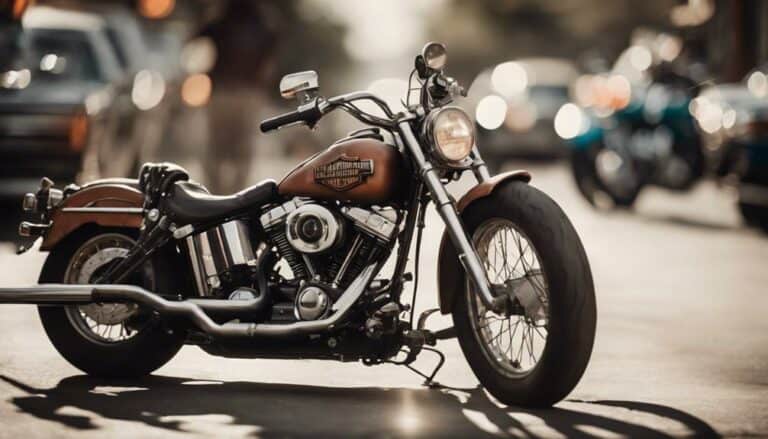If you're one of the 3.1 million households in the U.S. that own a motorcycle, you likely understand the importance of properly securing your prized possession during transport.
Harley Davidson's recommended techniques for strapping down their motorcycles go beyond just basic tie-downs; their strategic approach guarantees the utmost safety and stability.
Whether you're a seasoned rider or a novice enthusiast, knowing the ins and outs of Harley's strapping methods could make all the difference in safeguarding your bike on the road.
Key Takeaways
- Utilize front and rear tie-down points on the frame for securement.
- Prioritize frame over handlebars for stability and weight distribution.
- Secure the bike with ratchet straps around front fork and fender.
- Implement four secure anchor points for rear securement using swingarm and floor-mounted positions.
Proper Tie-Down Points
To guarantee the safe transportation of your Harley Davidson motorcycle, utilize the recommended front and rear tie-down points on the frame for securement.
While front tie-down points can be the front fork tubes or handlebars, it's important to prioritize the frame for stability.
The rear tie-down points, such as the passenger foot peg brackets or frame tubes, also play a significant role in securing your bike properly.
By focusing on the frame rather than the handlebars for tie-down points, you make sure that the weight distribution is ideal, reducing the risk of imbalance during transit.
This consideration is essential as it helps prevent unnecessary stress on the motorcycle components, safeguarding them from potential damage.
Following Harley-Davidson's guidelines and utilizing the designated tie-down points not only guarantees the safety of your motorcycle during transport but also provides peace of mind knowing that your prized possession is securely fastened for the journey ahead.
Recommended Strapping Techniques
When securing your Harley Davidson motorcycle, make sure to implement the recommended strapping techniques provided by Harley-Davidson for safe transportation. Begin by using wheel chocks to prevent side-to-side rocking.
Next, secure the bike with ratchet straps, making sure they wrap around the front fork and pass through the fender. It's important to adjust the strap tensioning properly to prevent any movement or potential damage during transit.
Additionally, utilize extra straps around the swingarm at the rear of the motorcycle, hooking them to floor-mounted positions for a stable hold. Remember to conduct regular safety checks every 10-15 miles to verify the tightness of the straps and make sure the motorcycle remains securely fastened.
Securement Equipment Overview
Utilizing wheel chocks, ratchet straps, and securement points is vital for safely transporting your Harley Davidson motorcycle. To guarantee a secure and stable ride, consider the following equipment overview and securement techniques:
- Wheel Chocks:
Harley-Davidson recommends using wheel chocks to prevent side-to-side rocking during transportation. These sturdy blocks help keep your motorcycle in place, reducing the risk of shifting during transit.
- Ratchet Straps:
Opt for ratchet straps made of nylon with ratcheting ends for tight and secure fastening. These straps offer a reliable way to bind your motorcycle to the trailer or truck bed, minimizing movement and potential damage during the journey.
- Securement Points:
Focus on the front fork and fender as key areas for wrapping and securing the straps. Additionally, make sure four points of contact for rear securement by using straps around the swingarm and floor-mounted positions. This thorough approach helps distribute the tension evenly, keeping your Harley Davidson safe and sound throughout the trip. Remember to perform regular safety checks every 10-15 miles to confirm that the straps remain tight and secure.
Step-by-Step Strapping Instructions
Guarantee a secure transport for your Harley Davidson motorcycle by following these step-by-step strapping instructions. To guarantee the loading balance and strap tensioning for your motorcycle, follow these steps:
| Step | Instructions |
|---|---|
| 1. Secure Front Tire | Wrap a ratchet strap around the front fork and pass it through the fender. |
| 2. Rear Motorcycle | Use another strap around the swingarm and hook it to a floor-mounted position. |
| 3. Check Tightness | Regularly check strap tensioning every 10-15 miles during travel to keep the motorcycle securely fastened. |
| 4. Utilize Wheel Chocks | Prevent side-to-side rocking during transportation by using wheel chocks. |
| 5. Safety Checks | Perform regular safety checks to guarantee the motorcycle remains tightly secured without any damage to fork seals. |
Safety Tips for Transporting
For safer motorcycle transport, make sure all straps are securely fastened and regularly checked for tightness during the journey. To guarantee a safe and secure transportation of your motorcycle, consider the following tips:
- Check Straps Regularly: Stop every 10-15 miles initially to inspect and tighten the straps to maintain proper tension and security.
- Use Wheel Chocks: Employ wheel chocks to prevent side-to-side rocking and secure the front tire firmly in place, reducing the risk of movement during transport.
- Four Points of Contact: Utilize ratchet straps around the front fork and fender, as well as the swingarm at the rear, to create four secure anchor points for your motorcycle, enhancing stability and safety during transportation.
Conclusion
To sum up, Harley Davidson provides valuable guidance on securely strapping down their motorcycles for transport. By following their recommended techniques and utilizing the proper equipment, you can guarantee a safe and smooth journey for your prized ride.
Remember to conduct regular safety checks to maintain the integrity of the straps and enjoy the ride with peace of mind.

